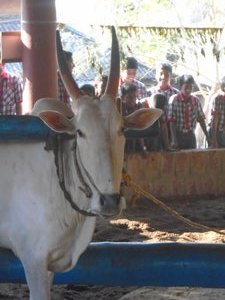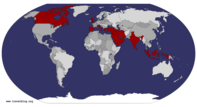Advertisement
Published: February 18th 2016

 Mangalore, India
Mangalore, India
Artisnal village. Extracting oil from seeds. Poor beast goes in endless circles.Mangalore, India. February 4, 2016.
Close to 10K nautical miles covered since Southampton.
A permanent industrial haze seems to linger over this city of 600K. The views from where we are docked are of massive piles of coal, massive conveyor belts and storage areas, and massive ships coming to collect it.
We watched them toss the lines for docking - much shouting, waving of arms and total lack of action from the shore workers until someone finally took charge and got the ship tied up.
There was a linear pile of coal about 15 meters high and perhaps 200 long. It was smoking in about eight places. As we noticed the smoke plumes, a fire truck entered the area. Leisurely is perhaps too active a word to describe their level of urgency; clearly, this occurrence is commonplace. Eventually they got a hose hooked up, and after standing around for several minutes, they got to work. As the water pressure removed the top layer of coal, the water hit the hot spots and erupted into clouds of grayish steam. They would soak it down and move on to the next plume.
In this humidity, the coal is
not going to dry out any time soon. If they measure by weight, someone is paying coal prices for waste water.
Disembarkation was so, so poorly organised. A standard condemnation made by travelers to India is of the damn British, who taught the Indians how to creat pointless and inflexible bureaucracy. The British freely admit this, ironically with a Gallic shrug.
We were given written instructions for disembarkation regarding Indian Immigration and the timetable thereof, which went completely out the window when the Immigration officers turned up an hour and a half late. This was combined with the cruise director continuing to make announcements which were mostly untrue and failed to keep up with the situation. This served to deeply annoy the folks who were trying to follow instructions, as everyone else decided it was a free-for-all. Imagine a thousand cranky retired people deciding to act childishly. It was a wonder there were no fisticuffs, people were so exercised.
We found Lijo Jose, of Muziris Heritage Day Tours, on Trip Advisor after reading a Cruise Critic tip. He was waiting for us as we disembarked, and introduced us to our guide, Nelson, a commerce student at a
Jesuit University in Mangalore (another vestige of the British). A native of Mumbai, his family is staunchly Catholic and English names are a part of that. He took our group of five out to the small but capacious air conditioned bus driven by Nathin. Introductions all around, Larry from Seattle and Brenda and Bill from Texas (who took the Texas separatist jokes with good humour).
In stereotypical Indian fashion, the driver's first task was to negotiate around the half-dozen cows wandering outside the terminal. We had heard stories of private tours returning late to the ship because local drivers refused to disturb the cow blocking the road.
Driving. Holy hell, do not look out the front windows if you do not have faith in your driver. Bill from Texas took some hair-raising photos and videos from his front seat. Tuk-tuks (3-wheeled vehicles seemingly powered by a weedwhacker 2-stroke), taxis, trucks and vans, motorcycles and scooters with sari-wearing passengers riding sidesaddle, many helmetless although helmets are the law, others wearing full-face helmets tipped back to reveal the face, or hard hats or unstrapped bicycle helmets. All these vehicles perform an ongoing, impossible ballet in two lanes of traffic turned
into five lanes of bobbing and weaving. Most amazing is that most vehicles retain their side mirrors.
First to the "Artisanal Village," where we chatted with and watched the local potters, weavers, rice processors, oil extractors and woodworkers. The woodworkers were the only group using power tools. All else was done by hand (weaving, pottery, and rice hulling and flattening) or by oxen, trudging in an eternal circle, yoked to a central press which extracts vegetable oils, such as sesame. Nelson pronounced it the local way, seize-aim, which first caused confusion, then amusement.
We had the whole place to ourselves at first, which was, evidently, part of Nelson's plan to keep the group small and away from crowds (no easy task anywhere in India). Then the first busload of field-tripping schoolkids, ages from about 8 to 14. They were very shy at first, but emboldened by our smiles and waves, crowded around to politely practice their English. "Where you from sir? What you name? Can you give me coin from your country?" Sadly, we had none. Nevertheless, Brenda accumulated the largest entourage, mostly girls fascinated by her hair and skin. I had a line of several boys wanting
to shake my hand and ask my name, too excited to give their own in return. Bill, being NFL-sized, was held in awe by the slight young men.
Nelson offered us some options, and we all agreed that a visit to see his home and meet some of his family would be a welcome, interesting and immersive opportunity not available to those on the bulk tours. Their pride of home and family are clear, and his auntie and father were waiting to greet us with mango juice and cookies.
His father, Joseph, is a property owner in Mumbai and Mangalore, and had upgraded one of his local properties so that the lower level could be rented as a single apartment. Nelson, one of his brothers, and an auntie who cares for them and for the home have the next two levels above the ground floor. Two bedrooms, two baths, living and dining rooms, a kitchen and a large balcony area.
They had also turned the rooftop into a patio, which they had roofed over again for an additional floor, outdoors but protected from sun and rain so that it can be used year-round. Everything was freshly painted and sparkling clean. When we commented, they said proudly that everything was ready for Nelson's parents' 25th wedding anniversary party in two days' time. They described with pride the flowers and catering they had planned for the several score of family and friends they were expecting.
Then off to a Hindu temple complex, a pristine and bright compound containing perhaps dozens of shrines to the millions of Hindu gods. Members of our group accepted a forhead mark from a monk after donating to the monkey god. A blessing from the monkey god seemed redundant, so I sought a temple to Ganesha. Although I found several statues and other depictions of the elephant-headed remover of obstacles, there were no attendant monks to bless me in his name.
Amazing statues and figurines, wall paintings, floor mosaics, inlaid columns. There were many ceremonies going on simultaneously, and the wedding buildings were in perpetual changeover. The wedding buildings are shamelessly divided by caste, which these days means more of a rich vs. less rich vs. poor situation than a low birthright or restriction of rights.
At the entrance, I noticed a dog snoozing in the shade. The tip of his muzzle was right at the edge of shadow, and in a minute the sun would creep up and begin toasting him. I took some temple photos and looked back just as this happened. This was not the dog's first rodeo- he didn't even open his eyes as the sun touched his black nose, just pushed against the tile with his front legs so he moved just enough to buy himself another hour of shade.
Lunch was at an elegant, modern downtown hotel. When we mentioned this to others who toured different areas, they were skeptical that there was anything elegant in the city that wasn't religion-based. There was a little anxiety in our group when told we were responsible for the cost of our own lunch; we rather assumed it was included. However, we were all delighted at the lower than expected bill. 420 rupees per person, about $6-7 US for a fabulous Indian buffet. Papdums and masala dosais (vegetable-stuffed pancakes), curries of vegetable, of fish, of various meats, General Tso's chicken Indian style, several kinds of rice and an assortment of mysterious but stupendously tasty sweets.
Nelson valiantly showed us various "famous" buildings, including his Jesuit college and an admittedly impressive-looking teaching hospital. He took us to the beach near the port. A nice sandy beach, but industrially-tainted water and a high tide line of single sandals, plastic bags and water bottles. The cashew processing factory is a major employer and was on our itinerary but it was a low priority to buy cashews so we saw some more "famous" buildings instead.
Unintended language humour is always fun: Dolphin Seafood Restaurant, Homely Meals Restaurant.
It's a densely crowded city. Not really a lot to see, althought it was a very immersive day with a most solicitous, eager to please and friendly guide. My dear friend Susan had spend a lot of time in India many years ago, and had many suggestions for us for Mumbai and Kochi, culled from her travel journal. She said she knew she had spent a week in Mangalore, but she was puzzled that her journal lacked entries for that week.
I think I know why, Sue.
Advertisement
Tot: 0.151s; Tpl: 0.011s; cc: 9; qc: 55; dbt: 0.0622s; 1; m:domysql w:travelblog (10.17.0.13); sld: 1;
; mem: 1.2mb









